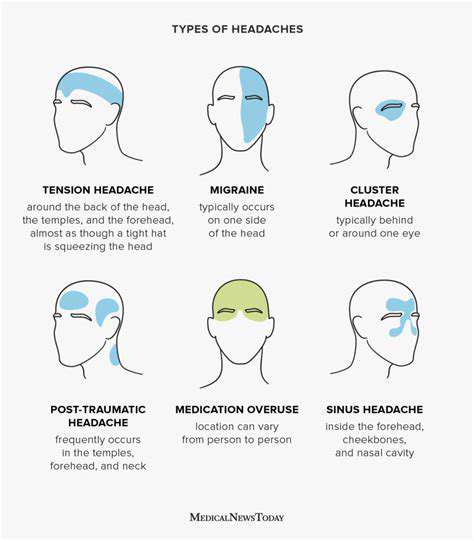Identifying Your Specific Headache Needs

Understanding the Spectrum of Headaches
Headaches present themselves in countless variations, from barely noticeable discomfort to excruciating pain that disrupts daily life. Noticing the unique features of your headache - where it hurts, how bad it feels, and how long it lasts - forms the foundation for proper diagnosis and care. Each headache type follows its own rhythm and responds to different factors; recognizing these patterns helps uncover what's really causing your pain. Getting this right matters because it leads to treatments that actually work.
Where your headache lives tells an important story. Pain behind the eyes often means something different than pain at your temples. Keeping track of these details helps doctors eliminate wrong guesses and focus on likely causes. Many people find keeping a headache diary helps spot these important patterns over time.
Analyzing the Location of Pain
Your headache's address matters more than you might think. Is the pain camped out in your forehead, setting up shop at your temples, or settled in at the back of your skull? Does it move around like a restless traveler? Pain that sticks to one side often points to different causes than pain that takes over your whole head. Becoming a careful observer of your pain's favorite locations provides the first clues in solving your headache puzzle.
Think of headache location like coordinates on a map leading to answers. Eye-area pain might connect to vision issues, while neck-related pain could suggest tension problems. The better you can describe exactly where it hurts, the better equipped your doctor will be to help.
Assessing the Intensity and Duration of Pain
How much your headache hurts and how long it overstays its welcome both tell important stories. A headache that hits like a thunderclap demands immediate attention, while a dull ache that lingers for days needs different consideration. Tracking these details creates a clear picture that helps healthcare providers understand what they're dealing with.
Imagine your headache's intensity and duration as vital signs, just like temperature or blood pressure. Sudden, severe pain might signal danger, while persistent discomfort could indicate something chronic. Writing these details down helps you remember them accurately when talking to your doctor.
Considering Associated Symptoms
Headaches rarely travel alone - they often bring unwelcome companions. Nausea, light sensitivity, or neck stiffness can reveal what kind of headache you're dealing with. These extra symptoms sometimes act as warning signs that something serious might be happening. Giving your doctor the full picture, including these side effects, helps them make better decisions about your care.
Evaluating Potential Triggers
Your headaches might be reacting to something in your world. Maybe stress sets them off, or certain foods invite them in. Even weather changes can play a role for some people. Discovering these triggers gives you power - once you know what starts your headaches, you can often avoid those situations. It's like learning what makes a bully leave you alone.
Examining Your Medical History
Your past holds clues to your present headaches. Previous similar episodes or existing conditions like migraines create important context. This historical perspective helps doctors see patterns and make connections that might otherwise stay hidden. It's like giving your doctor the previous chapters of your headache story so they understand the whole book.
Seeking Professional Advice
While self-observation helps, professional guidance makes all the difference. Persistent or severe headaches deserve medical attention. Getting help early often leads to better outcomes and prevents small problems from becoming big ones. Think of your doctor as a headache detective - the more clues you provide, the better they can solve your case.
Considering the Scope of Treatment Options

Defining the Treatment Scope
Creating the right treatment plan requires looking at the whole picture, not just the pain. A good evaluation considers your complete health history and current situation. The best treatments don't just mask symptoms - they address what's causing them while considering how treatment might affect your future health. This big-picture thinking leads to solutions that last.
Clear communication about what treatment can and can't do prevents misunderstandings. When doctors explain both the potential benefits and limitations of different approaches, patients can make truly informed choices about their care.
Factors Influencing Treatment Scope
Your personal situation shapes what treatments make sense for you. Your daily routine, support system, and even financial situation all matter. Having people to help you through treatment often makes the difference between success and struggle. Meanwhile, insurance coverage and costs can't be ignored when planning realistic care options.
More complex health issues naturally require more comprehensive solutions. Sometimes multiple specialists need to work together, while simpler cases might need just one focused approach. The key is matching the response to the actual need - not over-treating or under-treating.
Realistic Treatment Expectations
Hope matters in healthcare, but unrealistic expectations can backfire. Understanding what treatment can realistically achieve prevents disappointment and builds trust between patients and providers. Some conditions improve completely, while others require ongoing management - knowing this difference upfront helps everyone.
Medicine has limits, and acknowledging this honestly helps patients prepare for all possibilities. This transparency creates stronger partnerships in care, where both doctor and patient work with the same understanding of what's possible.